Related Research Articles

The Avro Canada CF-105 Arrow was a delta-winged interceptor aircraft designed and built by Avro Canada. The CF-105 held the promise of Mach 2 speeds at altitudes exceeding 50,000 feet (15,000 m) and was intended to serve as the Royal Canadian Air Force's (RCAF) primary interceptor into the 1960s and beyond.
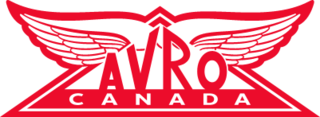
Avro Canada was a Canadian aircraft manufacturing company. It was founded in 1945 as an aircraft plant and within 13 years became the third-largest company in Canada, one of the largest 100 companies in the world, and directly employing over 50,000. Avro Canada was best known for the CF-105 Arrow, but through growth and acquisition, it rapidly became a major, integrated company that had diverse holdings.

Aerospace is a term used to collectively refer to the atmosphere and outer space. Aerospace activity is very diverse, with a multitude of commercial, industrial, and military applications. Aerospace engineering consists of aeronautics and astronautics. Aerospace organizations research, design, manufacture, operate, or maintain both aircraft and spacecraft.

The Goddard Space Flight Center (GSFC) is a major NASA space research laboratory located approximately 6.5 miles (10.5 km) northeast of Washington, D.C. in Greenbelt, Maryland, United States. Established on May 1, 1959 as NASA's first space flight center, GSFC employs about 10,000 civil servants and contractors. Named for American rocket propulsion pioneer Robert H. Goddard, it is one of ten major NASA field centers. GSFC is partially within the former Goddard census-designated place; it has a Greenbelt mailing address.
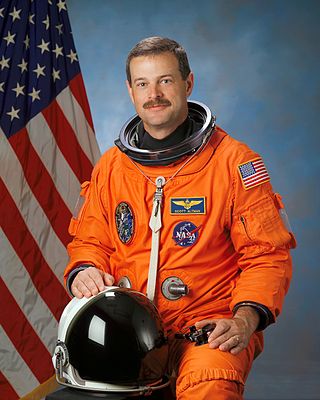
Scott Douglas "Scooter" Altman is a retired United States Navy Captain and naval aviator, engineer, test pilot and former NASA astronaut. He is a veteran of four Space Shuttle missions. His fourth mission on STS-125 was the last servicing mission to the Hubble Space Telescope. As of November 2022, he is the president of the Space operating group for ASRC Federal.
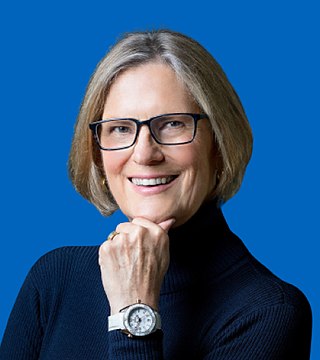
Kathryn Dwyer Sullivan is an American geologist, oceanographer, and former NASA astronaut and US Navy officer. She was a crew member on three Space Shuttle missions.

Duane Gene "Digger" Carey is a retired lieutenant colonel in the United States Air Force and a former NASA astronaut. He piloted the space shuttle Columbia on March 1, 2002, during a Hubble Space Telescope servicing mission.

Gregory Jordan Harbaugh is an aeronautical/astronautical engineer and former NASA astronaut. He flew on four space shuttle missions as a mission specialist with responsibilities that included Remote Manipulator System (RMS) operation and Extravehicular Activity (EVAs). He performed three spacewalks during the shuttle missions including in support of repair/refurbishment of the Hubble Space Telescope.

Homer Hadley Hickam Jr. is an American author, Vietnam War veteran, and a former NASA engineer who trained the first Japanese astronauts. His 1998 memoir Rocket Boys was a New York Times Best Seller and was the basis for the 1999 film October Sky. Hickam's body of written work also includes several additional best-selling memoirs and novels, including the "Josh Thurlow" historical fiction novels, his 2015 best-selling Carrying Albert Home: The Somewhat True Story of a Man, his Wife, and her Alligator and in 2021 the sequel to Rocket Boys titled Don't Blow Yourself Up: The Further Adventures and Travails of the Rocket Boy of October Sky. His books have been translated into many languages.
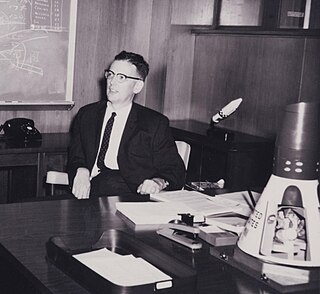
James Arthur Chamberlin was a Canadian engineer who contributed to the design of the Canadian Avro Arrow, NASA's Gemini spacecraft and the Apollo program. In addition to his pioneering air and space efforts, he is often cited as an example of Canadian brain drain to the U.S. In the early 1960s, he was one of the key people that proposed and moved that Lunar Orbit Rendezvous (LOR) was the best option for landing a crew on the Moon, the method eventually used on Apollo lunar landing missions. He left NASA in 1970 and worked for McDonnell Douglas, in their Houston offices, until his death in 1981.
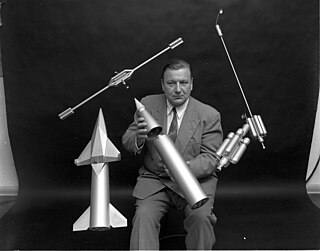
Krafft Arnold Ehricke was a German rocket-propulsion engineer and advocate for space colonization. Ehricke is a co-designer of the first Centaur liquid oxygen/liquid hydrogen upper stage.
This is a timeline of achievements in Soviet and United States spaceflight, spanning the Cold War era of nationalistic competition known as the Space Race.

James Charles Floyd is a British-Canadian retired aeronautical engineer. He became the Avro Aircraft Ltd. (Canada) chief design engineer and his involvement, ultimately as vice-president (engineering), in the design and development of the Avro Canada C-102 Jetliner, Avro Canada CF-100 Canuck and Avro Canada CF-105 Arrow aircraft, occurred during a period which is viewed by many as the "Golden Age" of the Canadian aviation industry.

The Space Task Group was a working group of NASA engineers created in 1958, tasked with managing America's human spaceflight programs. Headed by Robert Gilruth and based at the Langley Research Center in Hampton, Virginia, it managed Project Mercury and follow-on plans. After President John F. Kennedy set the goal in 1961 for the Apollo Program to land a man on the Moon and bring him back safely to Earth, NASA decided a much larger organization and a new facility was required to perform the Task Group's function, and it was transformed into the Manned Spacecraft Center, located in Houston, Texas.

John Dennis Hodge was a British aerospace engineer. He worked for the CF-105 Avro Arrow jet interceptor project in Canada. When it was cancelled in 1959, he became a member of NASA's Space Task Group, which later became the Johnson Space Center. During his NASA career, he worked as a flight director and planner. As the on-shift flight director of the Gemini 8 spaceflight crewed by Neil Armstrong and Dave Scott as it entered a spin, Hodge was credited with the safe landing of these astronauts.
Robert Godwin is a British author who has written about rock music and spaceflight. Early in his career he was a rock music impresario who managed a venue in Burlington, Ontario, and founded Griffin Music.

The National Aeronautics and Space Administration is an independent agency of the U.S. federal government responsible for the civil space program, aeronautics research, and space research. Established in 1958, NASA succeeded the National Advisory Committee for Aeronautics (NACA) to give the U.S. space development effort a distinctly civilian orientation, emphasizing peaceful applications in space science. NASA has since led most American space exploration, including Project Mercury, Project Gemini, the 1968–1972 Apollo Moon landing missions, the Skylab space station, and the Space Shuttle. NASA currently supports the International Space Station and oversees the development of the Orion spacecraft and the Space Launch System for the crewed lunar Artemis program, the Commercial Crew spacecraft, and the planned Lunar Gateway space station.
Owen Eugene Maynard was a Canadian engineer who contributed to the designs of the Canadian CF-105 Avro Arrow jet interceptor, and of NASA's Apollo Lunar Module (LM). Maynard was a member of the group of 32 Canadian and British engineers from Avro Canada who joined NASA when the Arrow was cancelled in 1959. Maynard worked on Project Mercury until 1960 and then moved to the Apollo program. Maynard won a U.S. patent (US3300162) in 1967 for a space station design.

Tecwyn Roberts was a Welsh spaceflight engineer who in the 1960s played important roles in designing the Mission Control Center at NASA's Johnson Space Center in Houston, Texas and creating NASA's worldwide tracking and communications network.
References
- 1 2 "Not Yet Imagined". December 16, 2020.
- ↑ "spacehistory101.com". spacehistory101.com. Retrieved June 27, 2023.
- ↑ "past-officers". August 6, 2017.
- ↑ "20041 Gainor".
- ↑ "Chris Gainor – Historian, Writer" . Retrieved June 27, 2023.
- ↑ "Winners since 1949".
- 1 2 "Arrows to the Moon - the Avro Arrow and the Lunar Module an Apogee Books Publication".
- 1 2 "Who Killed the Avro Arrow?" . Retrieved June 27, 2023.
- 1 2 "To a Distant Day".
- 1 2 Gainor, Christopher (2018). The Bomb and America's Missile Age | Johns Hopkins University Press Books. doi:10.1353/book.61257. ISBN 9781421426037.
- 1 2 "Canada in Space".